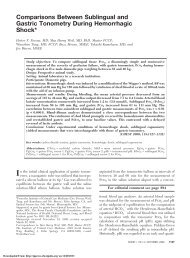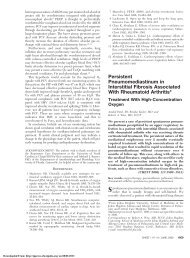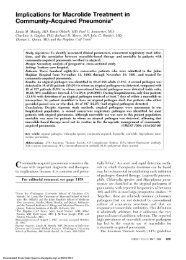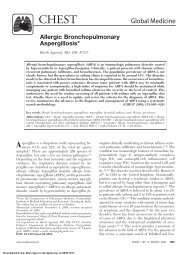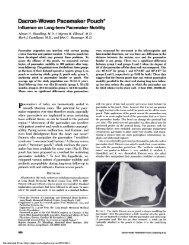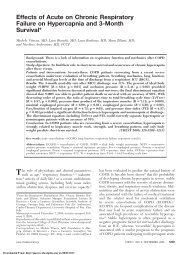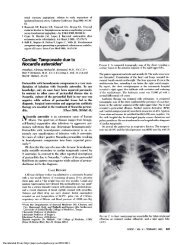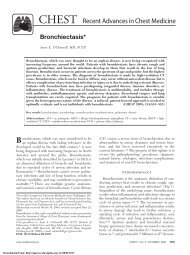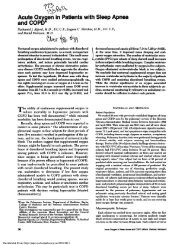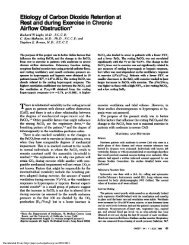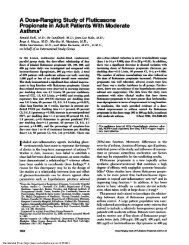Skeletal Muscle Adaptations to Interval Training in Patients With ...
Skeletal Muscle Adaptations to Interval Training in Patients With ...
Skeletal Muscle Adaptations to Interval Training in Patients With ...
Create successful ePaper yourself
Turn your PDF publications into a flip-book with our unique Google optimized e-Paper software.
such as oxygen supplementation or cont<strong>in</strong>uous positive<br />
airway pressure, have been employed. 13 An<br />
alternative approach that allows high-<strong>in</strong>tensity exercise<br />
<strong>to</strong> be performed for sufficiently long periods of<br />
time is <strong>in</strong>terval exercise (IE). In healthy subjects with<br />
this type of exercise, it is possible <strong>to</strong> impose maximal<br />
loads on both muscles and oxygen-transport<strong>in</strong>g organs<br />
without significant engagement of anaerobic<br />
processes, thus allow<strong>in</strong>g a great amount of work <strong>to</strong> be<br />
performed before exhaustion sets <strong>in</strong>. 15 In patients<br />
with advanced COPD, IE tra<strong>in</strong><strong>in</strong>g, consist<strong>in</strong>g of<br />
repeated bouts of high or even maximal-<strong>in</strong>tensity<br />
work separated by periods of lower <strong>in</strong>tensity work or<br />
rest, has been shown <strong>to</strong> be associated with a small<br />
<strong>in</strong>crease <strong>in</strong> lactate concentration, stable ventilation,<br />
and low symp<strong>to</strong>ms of dyspnea and leg discomfort,<br />
thus allow<strong>in</strong>g the <strong>to</strong>tal amount of work performed <strong>to</strong><br />
be significantly greater than at CLE tra<strong>in</strong><strong>in</strong>g. 16–17<br />
In addition, application of IE tra<strong>in</strong><strong>in</strong>g <strong>in</strong><strong>to</strong> pulmonary<br />
rehabilitation has been shown <strong>to</strong> be an equally<br />
effective alternative <strong>to</strong> moderately <strong>in</strong>tense CLE<br />
tra<strong>in</strong><strong>in</strong>g <strong>in</strong> terms of improv<strong>in</strong>g exercise <strong>to</strong>lerance and<br />
quality of life. 18 As there is evidence 19–20 that patients<br />
with advanced COPD have a significant metabolic<br />
reserve capacity that is only evident when<br />
muscle activity is somewhat freed from ventila<strong>to</strong>ry<br />
constra<strong>in</strong>ts, it was hypothesized that application of<br />
high-<strong>in</strong>tensity IE tra<strong>in</strong><strong>in</strong>g <strong>in</strong> the rehabilitation of<br />
these patients would <strong>in</strong>duce significant peripheral<br />
muscle adaptations lead<strong>in</strong>g <strong>to</strong> improvements <strong>in</strong> exercise<br />
<strong>to</strong>lerance. Consequently, the purpose of the<br />
present study was primarily <strong>to</strong> <strong>in</strong>vestigate the response<br />
<strong>to</strong> high-<strong>in</strong>tensity IE tra<strong>in</strong><strong>in</strong>g by specifically<br />
look<strong>in</strong>g at changes <strong>in</strong> morphologic and biochemical<br />
characteristics of the vastus lateralis muscle. In<br />
addition, we compared the magnitude of peripheral<br />
muscle adaptations <strong>in</strong>duced by high-<strong>in</strong>tensity IE<br />
tra<strong>in</strong><strong>in</strong>g <strong>to</strong> that <strong>in</strong>curred after implementation of the<br />
commonly applied moderately <strong>in</strong>tense CLE tra<strong>in</strong><strong>in</strong>g<br />
modality.<br />
*From the Department of Critical Care Medic<strong>in</strong>e and Pulmonary<br />
Services (Drs. Nanas, Stratakos, Simoes, Zakynth<strong>in</strong>os, and Roussos),<br />
Pulmonary Rehabilitation Centre, Evangelismos Hospital,<br />
and Thorax Foundation “M. Simou and G.P. Livanos Labora<strong>to</strong>ries”;<br />
Department of Physical Education and Sport Science (Drs.<br />
Terzis and Vogiatzis, and Ms. Georgiadou), National & Kapodistrian<br />
University of Athens, Athens, Greece.<br />
This work was supported <strong>in</strong> part by the European Community<br />
CARED FP5 project (No. QLG5-CT-2002–0893) and by the<br />
Thorax Foundation.<br />
Manuscript received March 4, 2005; revision accepted September<br />
26, 2005.<br />
Reproduction of this article is prohibited without written permission<br />
from the American College of Chest Physicians (www.chestjournal.<br />
org/misc/repr<strong>in</strong>ts.shtml).<br />
Correspondence <strong>to</strong>: Ioannis Vogiatzis, PhD, National & Kapodistrian<br />
University of Athens, Medical School, Thorax Foundation 3<br />
Ploutarhou Str. 106 75, Athens, Greece; e-mail:gianvog@phed.<br />
uoa.gr<br />
Subjects<br />
Materials and Methods<br />
<strong>Patients</strong> <strong>in</strong>cluded 16 men and 3 women with stable, advanced<br />
COPD who satisfied the follow<strong>in</strong>g criteria: (1) postbronchodila<strong>to</strong>r<br />
FEV 1 50% of predicted and FEV 1/FVC 70% without<br />
significant reversibility ( 12% change of the <strong>in</strong>itial FEV 1 value),<br />
(2) optimized medical therapy, and (3) no cl<strong>in</strong>ical evidence of<br />
exercise-limit<strong>in</strong>g cardiovascular or neuromuscular diseases. <strong>Patients</strong><br />
signed an <strong>in</strong>formed consent form that was approved by the<br />
University Ethics Committee.<br />
Study Design<br />
The study was designed as a randomized, controlled, parallel,<br />
two-group study. Once it was verified that patients met the<br />
selection criteria, they were randomly assigned <strong>to</strong> one of the two<br />
tra<strong>in</strong><strong>in</strong>g modalities: IE or CLE. Stratified randomization was<br />
used <strong>to</strong> achieve approximate balance of certa<strong>in</strong> characteristics<br />
(Table 1), <strong>in</strong>clud<strong>in</strong>g FEV 1 ( 40 or 40% of predicted) and<br />
peak work rate (Wpeak) [ 50 or 50 W] that was assessed by<br />
a ramp-<strong>in</strong>cremental cycle ergometer test.<br />
Pulmonary Function Assessment<br />
Spirometry and diffusion capacity of the lung for carbon<br />
monoxide (Dlco) were performed (Masterlab; Jaeger; Wurzburg,<br />
Germany) accord<strong>in</strong>g <strong>to</strong> recommended techniques. 21 Arterial<br />
blood gas was also analyzed at rest (ABL330; Radiometer;<br />
Copenhagen, Denmark).<br />
Rehabilitation Program<br />
The rehabilitation program was multidiscipl<strong>in</strong>ary and <strong>in</strong>cluded<br />
supervised exercise tra<strong>in</strong><strong>in</strong>g, breath<strong>in</strong>g control and relaxation<br />
techniques, methods of clearance of pulmonary secretions, disease<br />
education, dietary advice, and psychological support on<br />
issues relat<strong>in</strong>g <strong>to</strong> chronic disability. Similarly <strong>to</strong> our previous<br />
rehabilitation study, 18 the exercise prescription was designed <strong>to</strong><br />
present patients with a similar overall tra<strong>in</strong><strong>in</strong>g load. <strong>Patients</strong><br />
assigned <strong>to</strong> the IE group were <strong>in</strong>structed <strong>to</strong> exercise on electromagnetically<br />
braked cycle ergometers (Cateye Ergociser,<br />
ECl600; Cat Eye; Osaka, Japan) at an <strong>in</strong>tensity <strong>in</strong>itially targeted<br />
Table 1—Basel<strong>in</strong>e Lung Function Characteristics<br />
Between the IE and the CLE <strong>Tra<strong>in</strong><strong>in</strong>g</strong> Groups*<br />
Characteristics IE (n 10) CLE (n 9)<br />
Age, yr 64 3 67 2<br />
Body mass <strong>in</strong>dex,<br />
25.9 1.2 26.9 1.3<br />
kg/m 2<br />
FEV1, L (% predicted) 1.12 0.15 (44 6) 1.07 0.16 (39 6)<br />
FVC, L (% predicted) 2.64 0.28 (82 8) 2.67 0.27 (75 7)<br />
FEV1/FVC, % 42 4 44 6<br />
Dlco, % predicted 51 9 47 8<br />
IC, % predicted 71 6 71 12<br />
Pao2,mmHg 69 6 64 4<br />
Paco2,mmHg 39 1 41 1<br />
pH 7.43 0.01 7.44 0.01<br />
Arterial oxygen<br />
saturation, %<br />
94 1 92 1<br />
*Data are presented as mean SEM.<br />
www.chestjournal.org CHEST / 128 /6/DECEMBER, 2005 3839<br />
Downloaded From: http://jupcvss.chestpubs.org/ on 08/01/2013



